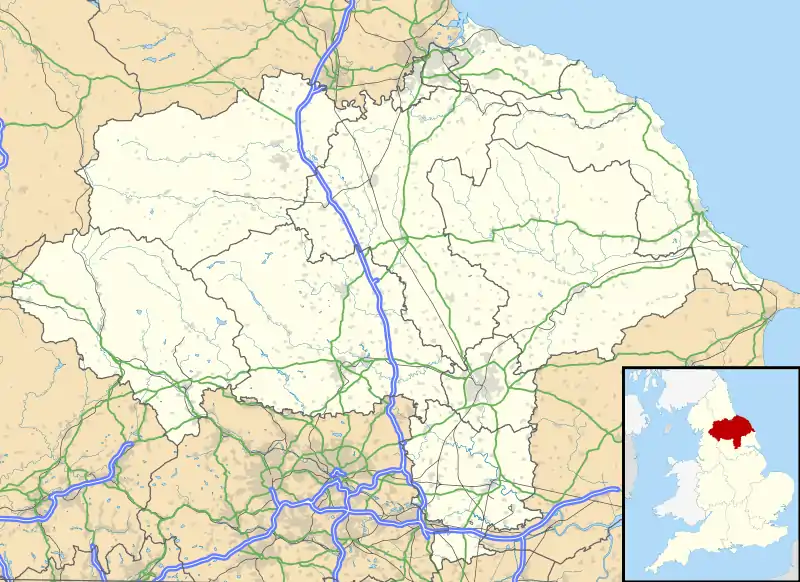Ampleforth Abbey
Ampleforth Abbey is a monastery of Benedictine Monks a mile to the east of Ampleforth, North Yorkshire, England, part of the English Benedictine Congregation. It claims descent from the pre-Reformation community at Westminster Abbey through the last surviving monk from Westminster Sigebert Buckley (c. 1520 - c. 1610).
| Ampleforth Abbey | |
|---|---|
| The Abbey Church of St Laurence, Ampleforth | |
 | |
 Ampleforth Abbey Location of within North Yorkshire | |
| 54.2018°N 1.0847°W | |
| OS grid reference | SE598788 |
| Location | Ampleforth, North Yorkshire |
| Country | England |
| Denomination | Catholic Church |
| Website | Abbey.Ampleforth.org.uk |
| History | |
| Status | Abbey |
| Founded | 1802 |
| Founder(s) | Lady Anne Fairfax |
| Dedication | St Lawrence the Martyr |
| Architecture | |
| Functional status | Active |
| Heritage designation | Grade I[1] |
| Designated | 9 September 1985[1] |
| Administration | |
| Deanery | Central |
| Diocese | Middlesbrough |
| Province | Liverpool |
| Clergy | |
| Abbot | Fr Cuthbert Madden OSB |
History

The Abbey was founded in a house given to Father Anselm Bolton by Lady Anne Fairfax, daughter of Charles Gregory Fairfax, 9th Viscount Fairfax of Emley.[2][3][4] This house was taken over by Dr. Brewer, President of the Congregation, 30 July 1802. The community, since leaving Dieulouard in Lorraine, where its members had joined with Spanish and Cassinese Benedictines to form the monastery of St Laurence, had been successively at Acton Burnell, Tranmere, Scholes, Vernon Hall, and Parbold Hall, under its superior Dr. Marsh.
On its migration to Ampleforth Lodge, Dr. Marsh remained at Parbold and Father Appleton was elected the first prior of the new monastery. Shortly afterwards Parbold was broken up and the boys of the school there transferred to Ampleforth. The priory was erected into an abbey, in 1890, by the Bull "Diuquidem". and has an important and flourishing college attached to it. John Cuthbert Hedley, Bishop of Newport, was an alumnus, as well a superior of Ampleforth, Abbot Smith. The monastery was finished in 1897.[5] The existing Abbey church was completed between 1922-24 and was designed by notable architect Giles Gilbert Scott, replacing the mid-19th century church of Charles Hansom.[6]

Coat of arms
Blazon: Per fesse dancetté Or and Azure a chief per pale Gules and of the second charged on the dexter with two keys in saltire Or and Argent and on the sinister with a Cross Flory between five martlets of the first. (College of Arms, London 1922). Ensigned with an abbot's crosier in pale behind the shield Or garnished with a pallium crossing the staff argent and a galero with cords and twelve tassels disposed on either side of the shield in three rows of one, two, and three all Sable.
List of Abbots
- 1900–1924: Oswald Smith OSB
- 1924–1939: Edmund Matthews OSB
- 1939–1963: Herbert Byrne OSB
- 1963–1976: Basil Hume OSB
- 1976–1984: Ambrose Griffiths OSB
- 1984–1997: Patrick Barry OSB[7]
- 1997–2005: Timothy Wright OSB
- 2005–present: Cuthbert Madden OSB
Ampleforth College
The monastery set up a school at Ampleforth in 1802. It is now the co-educational independent boarding school Ampleforth College, with about 600 students. Since 2020 the college has separated from the Abbey by splitting the site and each having their own independent governance.
Parishes
In addition to the work at Ampleforth, some of the monks are sent as parish priests to parishes,[8] mostly in Lancashire and North Yorkshire.
Permanent Private Hall
Ampleforth has a Permanent Private Hall at St Benet's Hall, Oxford, which was founded for the purpose of letting monks study for secular degrees. It now accepts lay undergraduates and graduates, as well as monastic members.
Saint Louis
Ampleforth set up a daughter house, the priory at St. Louis, Missouri in 1955. The priory gained independence in 1973 and became Saint Louis Abbey in its own right in 1989.
Zimbabwe
In 1996, Ampleforth set up the community of Christ the Word in Zimbabwe which has approximately four or five members of the community in residence at any one time. The present Abbot makes it a point to spend at least three months of the year at this monastery.
Gallery
 South Side of the Church
South Side of the Church East Side of the Church
East Side of the Church Ampleforth Abbey and College
Ampleforth Abbey and College Window in Abbey Church
Window in Abbey Church
References
- Historic England. "The Abbey Church (1315767)". National Heritage List for England. Retrieved 23 July 2017.
- Turner, Bede. "The Story of the Abbey Land" (PDF). Monastery Library & Archives. Ampleforth Abbey. Retrieved 8 August 2012.
- "Hon. Anne Fairfax". thepeerage.com. Retrieved 8 August 2012.
- "Fairfax, Viscount (I, 1629 - 1772)". Cracroft's Peerage. Archived from the original on 13 May 2012. Retrieved 8 August 2012.
- The Abbey of Ampleforth. Catholic Encyclopedia (1913).
- "Abbey Church | Ampleforth Visitors". www.ampleforth.org.uk. Retrieved 9 November 2020.
- "Our Benedictine Connection - Abbot Patrick Barry, OSB". Le Mée Studies. Archived from the original on 1 June 2010. Retrieved 21 August 2009.
- "Parishes & Partnerships | Ampleforth Abbey". www.ampleforth.org.uk. Retrieved 9 November 2020.
![]() This article incorporates text from a publication now in the public domain: Herbermann, Charles, ed. (1913). "The Abbey of Ampleforth". Catholic Encyclopedia. New York: Robert Appleton Company.
This article incorporates text from a publication now in the public domain: Herbermann, Charles, ed. (1913). "The Abbey of Ampleforth". Catholic Encyclopedia. New York: Robert Appleton Company.
External links
| Wikimedia Commons has media related to Ampleforth Abbey. |
- Official website
- Ampleforth Abbey (English Benedictine Congregation Web)